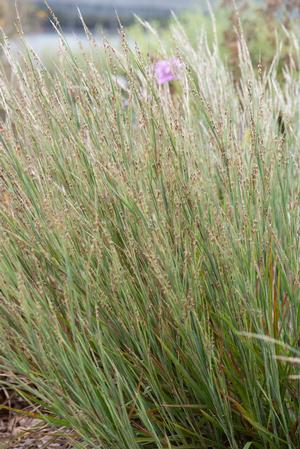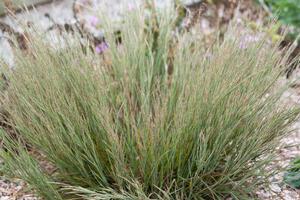





Plant Calculator
Enter the approximate length and width of the area you will be planting and click 'Calculate' to determine how many Schizachyrium littorale you will need.
Correct and successful spacing is complex and depends on project conditions. We encourage you to call us at 877-ECO-PLUG for project specific recommendations and further assistance.
Schizachyrium littorale
coastal little bluestem (dune bluestem)
- Category: Grass, Native
- Hardiness Zone: 3-10
- Height: 1-2 Feet
- Spread: 1-2 Feet
- Spacing: 12 Inches
- Bloom Color: Green
- Foliage Color: Blue
An underused but widely requested native warm-season grass, Schizachyrium littorale is a bushier version of the popular little bluestem, growing 2' tall. What makes it notable are the seedheads, which are featherier and stay on the stem well into the winter. We predict this dune bluestem to become a popular favorite in everything from dune restoration projects to coastal landscaping to low-maintenance high-exposure urban sites.
Exposure
| • | Full Sun |
Wetland Indicator Status
| • | Falcutative Wetland (FACW) |
Plug Type
| • | Landscape Plug™ |
Propagation Type
| • | Open pollinated |
Grass Type
| • | Warm Season |
Additional Information about Schizachyrium littorale
Coastal little bluestem is a short (1-2 foot) bunch grass with coarse blue-green stems and basal leaves which often appear purplish. Coastal little bluestem is very similar to the inland little bluestem but can be distinguished by the bent stems at the base, whereas little bluestem stems are erect. Leaves are smooth but frequently are covered with hair at the base next to the sheath. Leaves tend to fold with maturity. Seed head clusters are about three inches long and consist of a number of short, silvery hairs (awns) when the seeds are ripe. In the late summer to early fall a low sun slanting across the seed heads of this grass give the plant a frosty appearance. As a warm season grass, it begins growth in late spring and continues through the hot summer period until the first killing frost. The entire plant has a reddish cast after frost. Ragged brownishtan stems often persist through the winter. -USDA
Schizachyrium littorale is found in coastal beaches and dunes along the coastal strip from southern New England to Texas. Foliage provides cover for ground birds and small mammals.
Growing & Maintenance Tips for Schizachyrium littorale
Tolerant of a wide range of soils, but will not grow well in moist, fertile soils. Propagate by seed or division in spring. Self seeds, though not prolifically. Cut to the ground in spring before new growth emerges. Best useful as an ornamental planting in coastal landscapes. Because of natural physiological tolerance to hot, dry soils with little fertility, this plant is an excellent choice for “low input” sustainable landscape designs.
